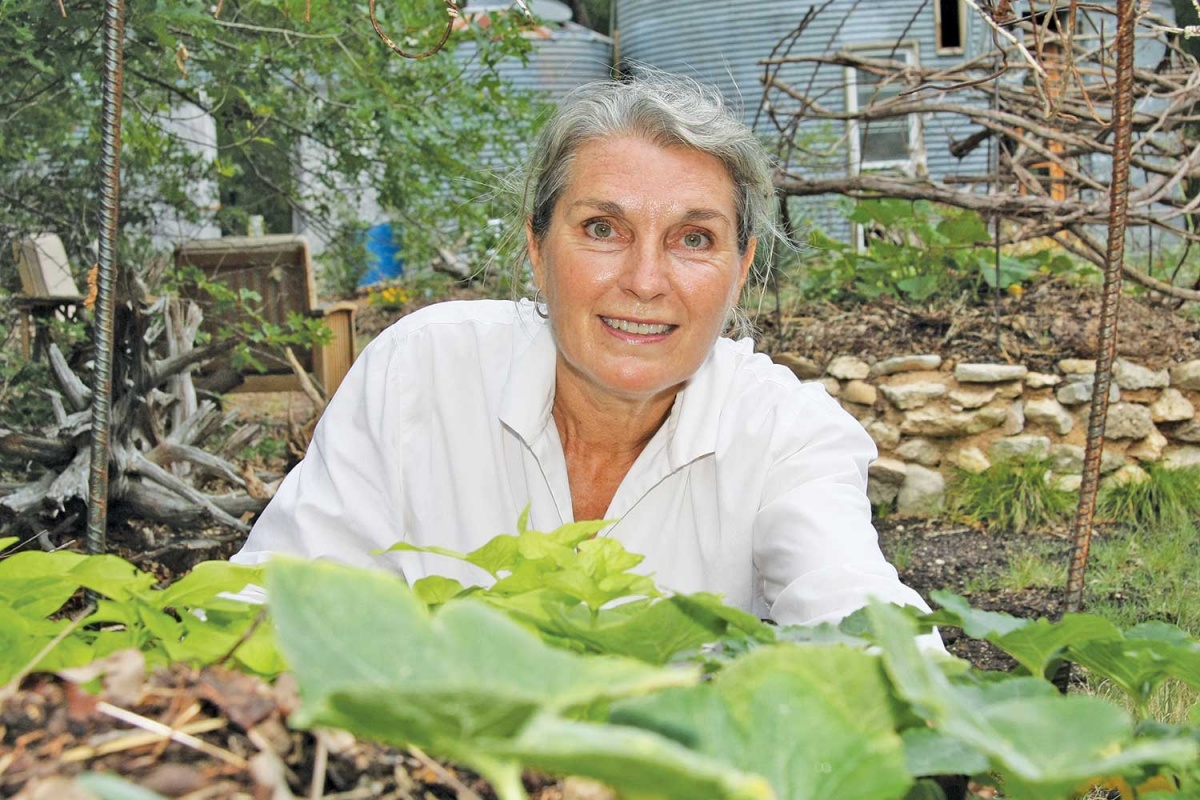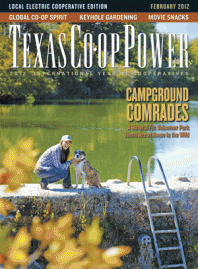During a drought, Texas has a lot in common with southern Africa. Scorching heat, thin layers of topsoil and elusive rainfall can make for a brutal summer when gardening is not for the faint of heart. Recent Texas droughts are the most severe on record, and the National Weather Service warns that the long-term forecast is drier still.
So it’s nothing short of amazing that the community of Clifton in Bosque County has been transformed into an oasis in this gardening desert with help from creative landscape architect Deb Tolman. Leaning on her 30 years of experience in landscape design, doctoral studies in environmental science and research on African survival strategies, Tolman has teamed with local ranch owners Jim and Mary Lou Starnater to unlock the secrets of sustainable gardening.
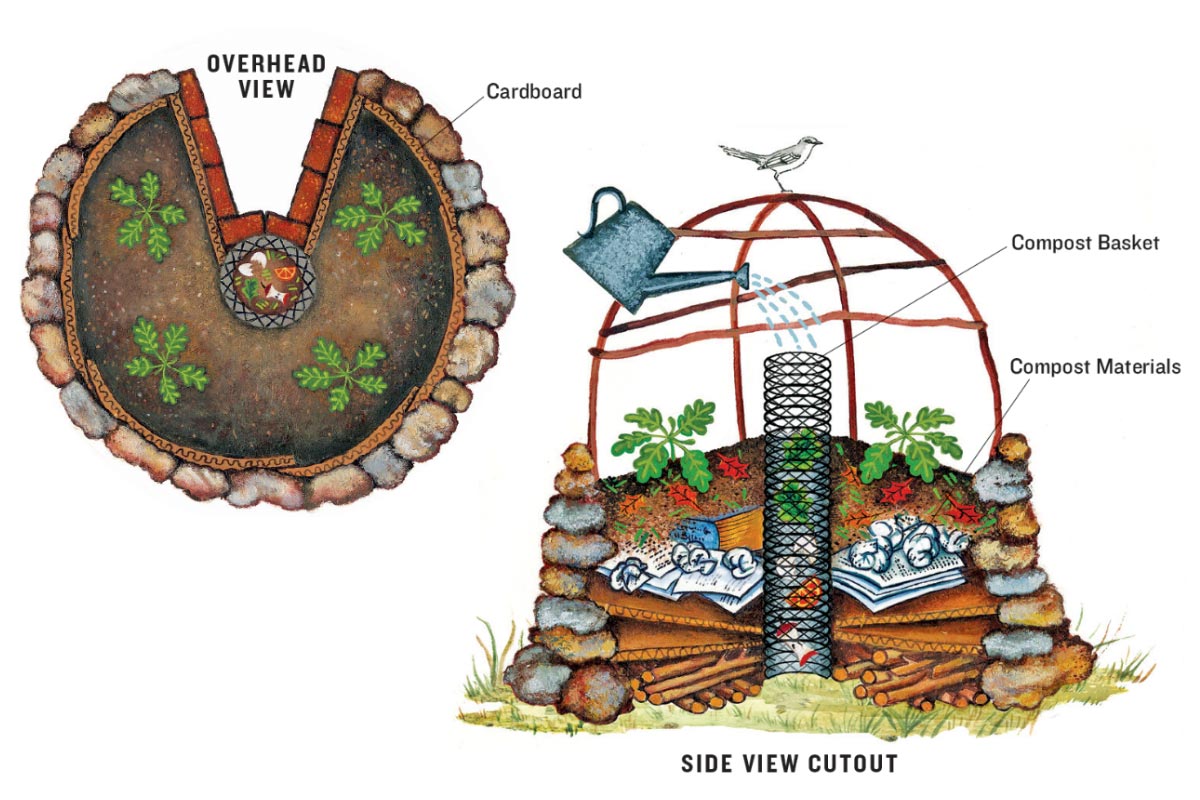
Aletha St. Romain
Affectionately known as “Dr. Deb,” Tolman lives “one block off the grid.” Living on the Starnaters’ StarHaven Ranch in a 10-by-10-foot converted oat bin, Tolman has access to electricity from United Cooperative Services, which serves the ranch, but uses no other public utilities. She grows her own food—even in hot, dry conditions—cooks in an outdoor oven, and every month hosts sustainability workshops on topics from rainwater harvesting to her most popular class—keyhole gardening.
Lessons from Africa
A keyhole garden is the ultimate raised-bed planter. It is often built in the shape of a circle measuring about 6 feet in diameter that stands waist-high and is notched like a pie with a slice cut away. A hole in the center holds a composting basket that moistens and nourishes the soil. The garden, which from above looks like a keyhole, can be built with recycled materials and requires less water than a conventional garden.
“It works well in places far drier than we are here on the edge of the Hill Country,” says Tolman, who discovered the technique five years ago. The sustainable gardening method was developed by a humanitarian aid organization in southern Africa, where resources are scarce and the climate unforgiving. There, three keyhole gardens can feed a family of 10 all year long, reports the BBC.
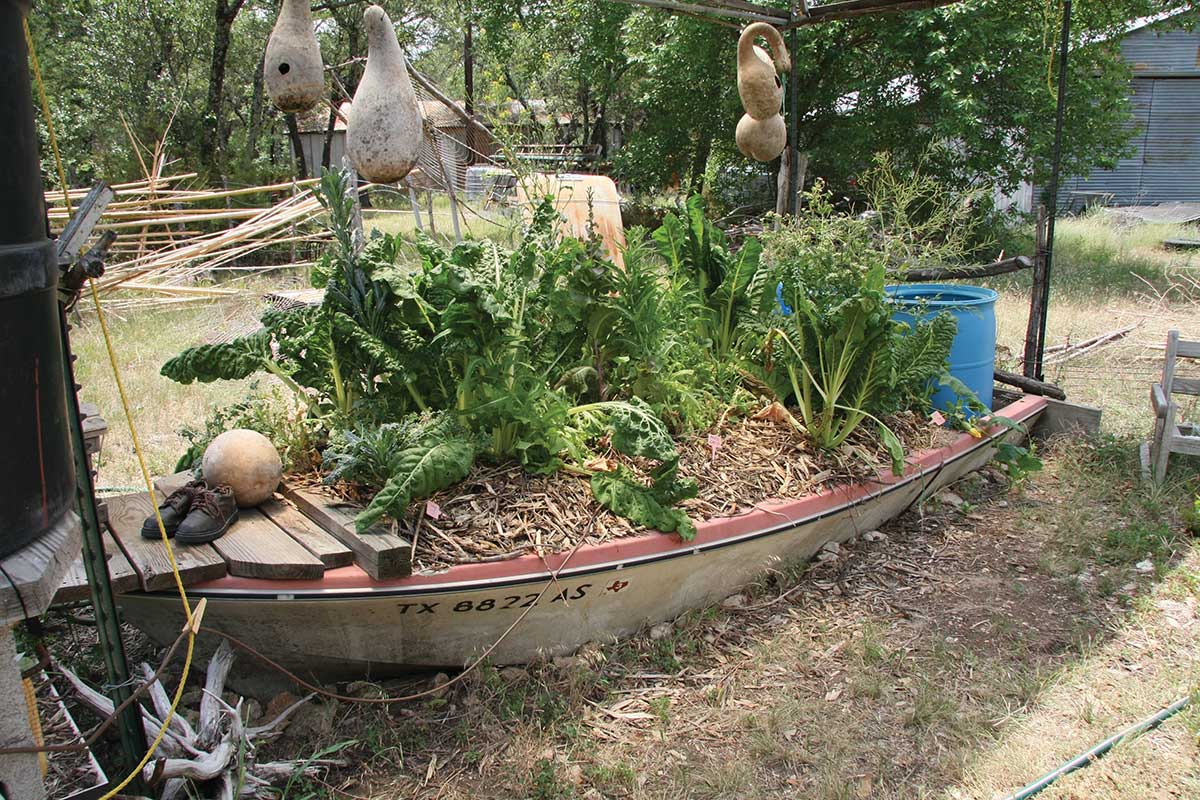
Even old boats can be filled with compost and turned into keyhole gardens. This mix of Swiss chard, kale and Malabar spinach has grown prolifically, including during extreme summer heat.
Bill Smith
In her area of North Central Texas, Tolman has added a twist to keyhole gardens, making beds almost entirely of compost. Some of the soil is composed of recycled newspapers, telephone books and cardboard, which she says adds carbon, nitrogen and air to the soil. In Tolman’s garden, cardboard is gold, and what it buys is priceless.
“You don’t have to spend $400 a month on groceries when you can grow healthy produce at home,” she says. “In the summertime, I grow Malabar spinach, which loves the heat. The chard’s been going all year. I can eat a power snack of French green beans right off the vine.” Her harvest also includes carrots, kale, tomatoes, berries and more, rivaling Texas farmers markets. “I eat year-round from these gardens,” says Tolman.
Texas Keyhole Gardens
Tolman is sharing these ideas with the community, and Clifton now has about 60 keyhole gardens.
“My first keyhole garden here in Clifton was at Ace Hardware,” says Tolman, describing a demonstration garden maintained by the hardware store. “We used native rock and clay to build the walls, and recycled paper and manure to make soil. In just four weeks, 129 phone books were no longer discernable, and half a Dumpster load of cardboard from Ace Hardware had become soil.”
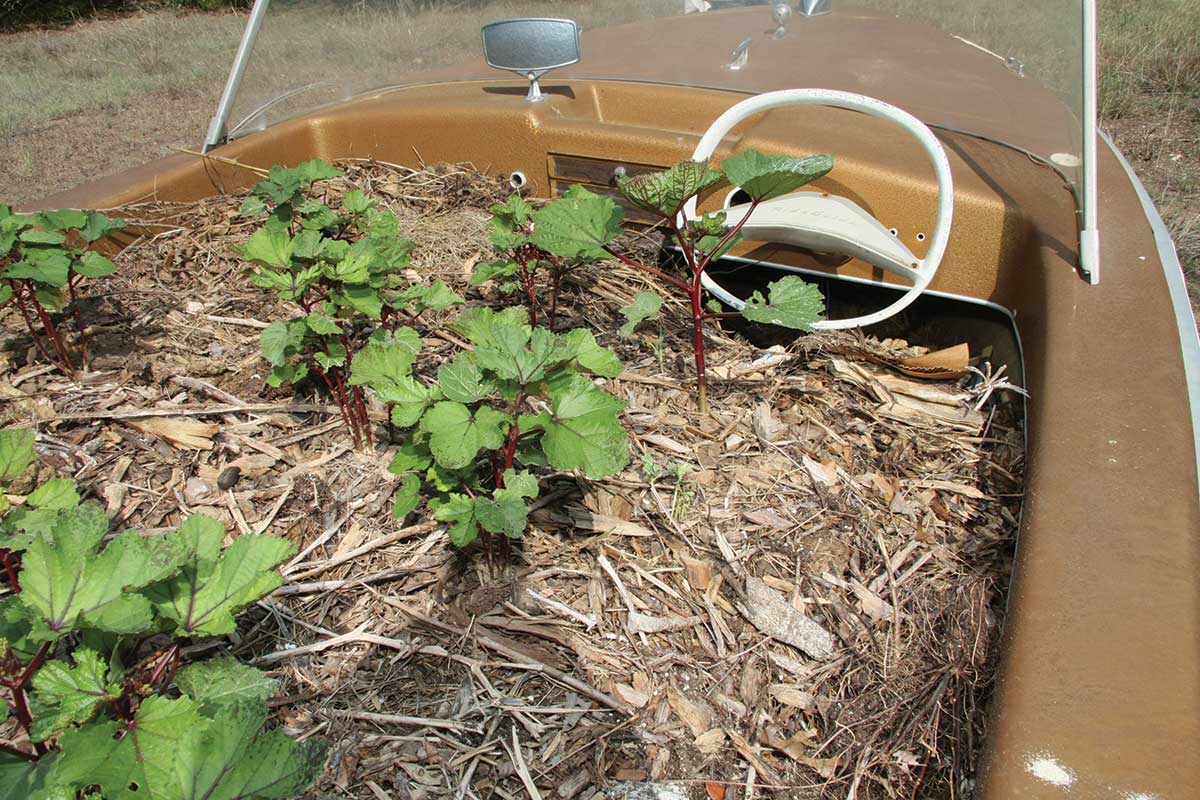
Thick layers of mulch hold in moisture from drip irrigation to help plants get started and minimize the amount of water required.
Bill Smith
Jim Starnater has helped build three community keyhole gardens in Clifton and has built several on his ranch. He was skeptical when he first attended one of Tolman’s workshops and saw photos of a beautifully productive raised-bed garden built on a mutual friend’s property. “I thought that garden was several years old,” he says. “But it had been planted just seven months before. You’re not going to start anything else in Bosque County that grows like that.”
While the keyhole provides easy access to the composting basket in the center, almost any raised bed about 6 feet in diameter will work. “You can adapt the concept to whatever you have available,” Starnater says. “We’ve experimented with various things, from old, leaking cattle water troughs to tractor and truck tires. Personally, I’m not into ‘pretty.’ I’m into function and efficiency. I’m interested in how to produce the largest amount of nutritious, organic food in the least amount of space with the least amount of water.”
Tolman, who appreciates both form and function, has worked with Starnater to turn an old ski boat and a bathtub into gardens in addition to her more traditional stone designs.
Drought Hardy
Clifton resident Rosa Peitz met Tolman through the Clifton Garden Club. “I’d never heard of keyhole gardens before Dr. Deb’s workshop,” says Peitz, “but I liked the idea of a garden where I didn’t have to bend over and that would only use a gallon or two of water every day.”
Tolman had suggested using rocks and cob, a mixture of clay and straw, but Peitz didn’t have either. Instead, she and her son used broken concrete from a house remodeling project, mortaring it with cement to create a frame for her now-prosperous garden. “This year, he’s got eight or nine different kinds of peppers growing in it, and we’ll easily harvest several thousand peppers,” Peitz says. “During the drought, when almost everyone had given up on their gardens, the keyhole gardens were thriving.”
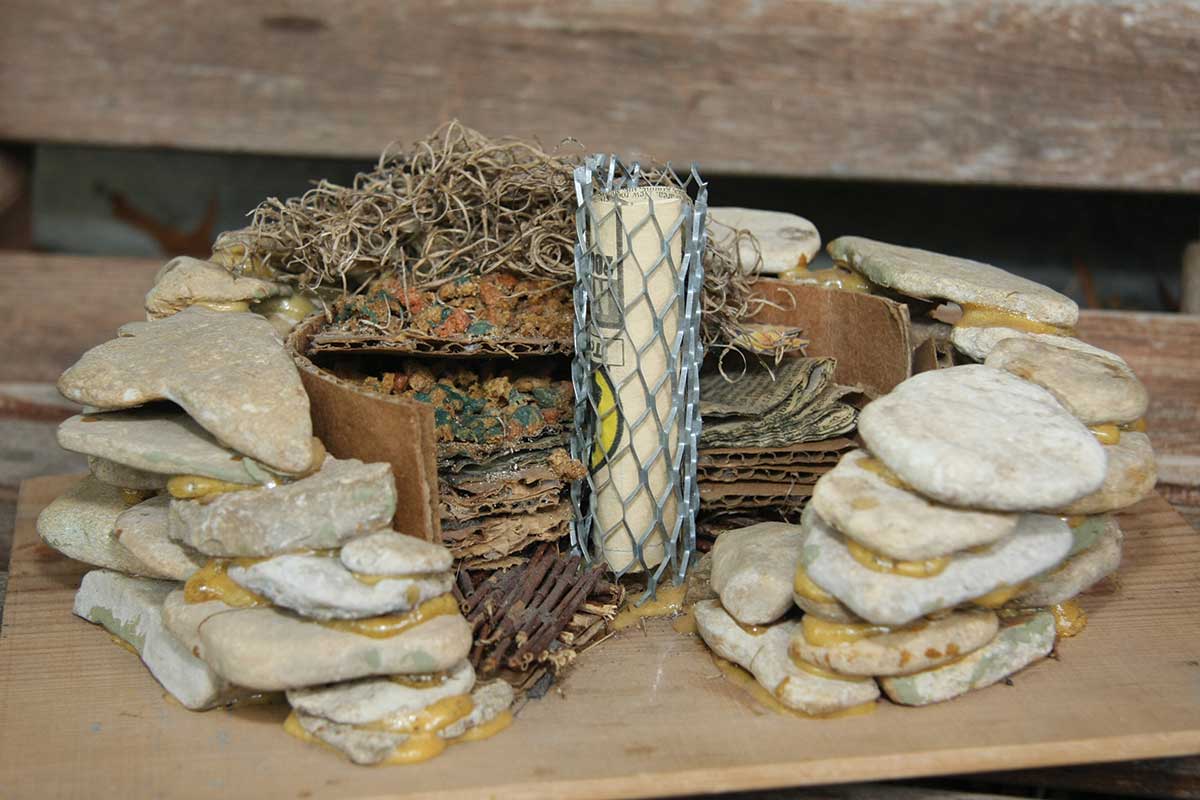
A demonstration model used in workshops.
Bill Smith
Tolman’s and Starnater’s gardens also continued to produce during the 2011 drought, although extra water and care were required. “If you go through a Texas summer with more than 60 days over 100 degrees, nothing’s going to grow if you don’t water it,” says Starnater. “But we used drip irrigation and a thick layer of mulch, which reduced the amount of water required by about 30 percent. We also created umbrellas to shade the plants and reduce the heat and sun exposure by about 60 percent. That makes a big difference.”
Because keyhole gardens can both weather the drought and take a big bite out of the grocery bill, they’re a welcome gift from Africans to Texans for bountiful seasons to come.
